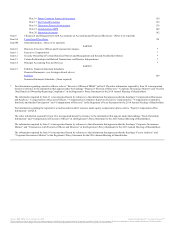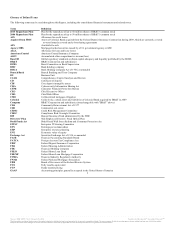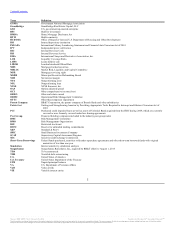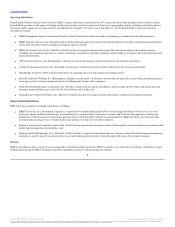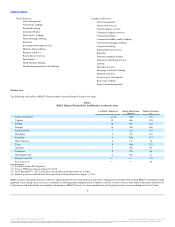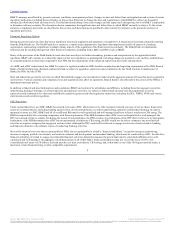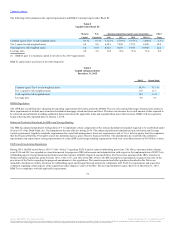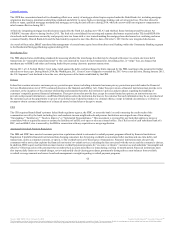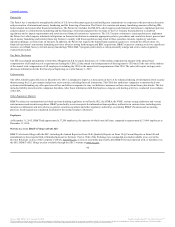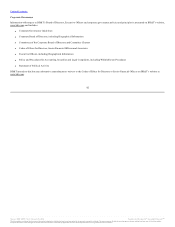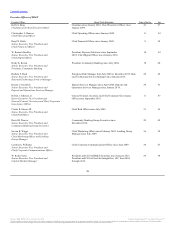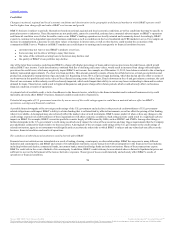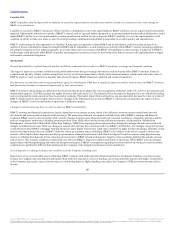BB&T 2015 Annual Report Download - page 14
Download and view the complete annual report
Please find page 14 of the 2015 BB&T annual report below. You can navigate through the pages in the report by either clicking on the pages listed below, or by using the keyword search tool below to find specific information within the annual report.
TableofContents
Federal law also requires the regulatory agencies to implement systems for “prompt corrective action” for institutions that fail to meet minimum capital
requirements within the five capital categories, with progressively more severe restrictions on operations, management and capital distributions according to
the category in which an institution is placed. Additionally, failure to meet capital requirements may cause an institution to be directed to raise additional
capital. Federal law further mandates that the agencies adopt safety and soundness standards generally relating to operations and management, asset quality
and executive compensation, and authorizes administrative action against an institution that fails to meet such standards.
In addition, failure to meet capital guidelines may subject a banking organization to a variety of other enforcement remedies, including additional
substantial restrictions on its operations and activities, termination of deposit insurance by the FDIC and, under certain conditions, the appointment of a
conservator or receiver.
U.S. Implementation of Basel III
During 2013, the FRB published final rules establishing a new comprehensive capital framework for U.S. banking organizations known as Basel III. The rules
substantially revise the risk-based capital requirements applicable to BHCs and IDIs, including BB&T and Branch Bank. The rules define the components of
capital and address other issues affecting banking institutions' regulatory capital ratios. The rules also address risk weights and other issues affecting the
denominator in banking institutions' regulatory capital ratios and replace the existing risk-weighting approach, which was derived from Basel I capital
accords of the BCBS, with a more risk-sensitive approach based, in part, on the standardized approach in the BCBS's 2004 “Basel II” capital accords. The
Basel III rules also implement the requirements of Section 939A of the Dodd-Frank Act to remove references to credit ratings from the federal banking
agencies' rules. BB&T qualifies as a standardized approach banking organization and was required to comply with the new requirements beginning on
January 1, 2015.
Institutions with greater than $250 billion in assets or $10 billion in foreign assets are considered advanced approaches banking organizations, which results
in a more complex calculation of RWA that includes an assessment of the impact of operational risk, among other changes. In addition, advanced approaches
institutions have additional reporting requirements and must calculate capital under both the standardized approach and the advanced approaches and use
the more conservative result. BB&T is preparing to comply with the advanced approaches requirements as it would become subject to these requirements
upon exceeding either of the asset thresholds.
The Basel III rules, among other things, (1) introduce a new capital measure referred to as common equity Tier 1; (2) specify that Tier 1 capital consist of Tier
1 common equity and additional Tier 1 capital instruments meeting specified requirements; (3) define Tier 1 common equity narrowly by requiring that most
deductions/adjustments to regulatory capital measures be made to Tier 1 common equity and not to the other components of capital; and (4) expand the
scope of the deductions/adjustments from capital as compared to existing regulations.
The Basel III rules prescribe a standardized approach for risk weightings that expand the risk-weighting categories from the four Basel I-derived categories
(0%, 20%, 50% and 100%) to a much larger and more risk-sensitive number of categories, depending on the nature of the assets. The Basel III risk weight
classifications generally range from 0% for U.S. government securities to 600% for certain equity exposures, with a maximum risk weight classification of
1,250% for certain securitizations. This results in higher risk weights for a variety of asset categories. In addition, the rules provide more advantageous risk
weights for derivatives and repurchase-style transactions cleared through a qualifying central counterparty and increase the scope of eligible guarantors and
eligible collateral for purposes of credit risk mitigation.
The Basel III rules revise the “prompt corrective action” directives by establishing more conservative ratio levels for well-capitalized status. In addition to the
minimum risk-based capital requirements, all banks must hold additional capital, the capital conservation buffer (which is in the form of common equity), to
avoid being subject to limits on capital distributions, such as dividend payments, discretionary payments on Tier 1 instruments, share buybacks, and certain
discretionary bonus payments to executive officers, including heads of major business lines and similar employees. The required amount of the capital
conservation buffer will be phased-in annually through January 1, 2019.
BB&T is considered to be a “modified LCR” holding company. BB&T would be subject to full LCR requirements if its operations were to fall under the
“internationally active” rules, which would generally be triggered if BB&T’s assets were to increase above $250 billion. BB&T produces LCR calculations
to effectively manage the position of High-Quality Liquid Assets and the balance sheet deposit mix to optimize BB&T’s liquidity position. BB&T’s LCR
was approximately 130% at December 31, 2015, compared to the regulatory minimum for such entities of 90%, which puts BB&T in full compliance with the
rule. The regulatory minimum will increase to 100% on January 1, 2017.
10
Source: BB&T CORP, 10-K, February 25, 2016 Powered by Morningstar® Document Research℠
The information contained herein may not be copied, adapted or distributed and is not warranted to be accurate, complete or timely. The user assumes all risks for any damages or losses arising from any use of this information,
except to the extent such damages or losses cannot be limited or excluded by applicable law. Past financial performance is no guarantee of future results.


